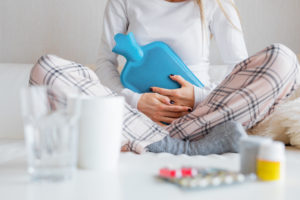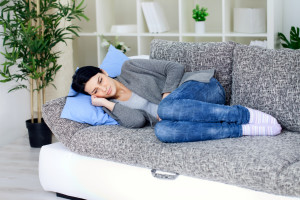
What causes cramps?
Many women experience menstrual cramps, either a few days before they get their period or in the first few days—when the cramps are likely to be more painful. Cramps are caused by contractions in the uterus and cause pain in the lower belly area. These contractions help the period blood flow out. Cramps are usually more prevalent when people first start menstruating, but this does not mean that they completely disappear as women age; they usually become less painful, but they may also become more painful.
Over-the-counter Medication
One of the quickest ways to deal with menstrual cramps is to take an over the counter medication. Though in cases of extreme pain, doctors will prescribe pain medication to their patients, anti-inflammatory over the counter medicine such as ibuprofen, aspirin, and naproxen sodium are most commonly used. While you may be inclined to start taking the medicine once the pains begin, anti-inflammatory medications actually work best if you take them before you start hurting too bad or the day before your period begins. It is recommended to keep taking the medicine for as long as the pain continues, but there are home remedies that you may find ease the pains as well.
Heat
Heat helps muscles relax and this is no different when it comes to menstrual pains. Applying a heating pad, a hot water bottle, or a heat wrap to your abdomen may work as well as medication to relieve cramps. If you do not own these items, you may use a hot towel or take a hot bath/shower to help relax your muscles.
Exercise
In a similar manner, exercising helps the flow of menstrual blood and its quicker, easier discharge. Additionally, exercising helps release endorphins, brain chemicals that promote general well-being. You can enjoy any form of exercise that works for you during your period, but if you find regular exercise difficult you can consider gentler forms of it, such as walking or yoga.
Diet and Hydration
Though they don’t work as quickly as medicine, heat, or exercise, proper diet and hydration can help your body deal with menstrual pains. Bloating is probably one of the most uncomfortable parts of menstrual pains and drinking more water than usual during your period can help you feel better; since you are also losing fluids, try to drink at least 6 to 8 glasses of water per day.
You may be craving salty and/or sweet kinds of food during your period, but these do not actually help with the menstrual pain. Instead, you may want to try consuming more anti-inflammatory foods such as cherries, blueberries, tomatoes, bell pepper, and squash. Cinnamon, ginger, dill, and turmeric consumption also helps with the pains.
Takeaway
Whatever route you choose to take to help you lessen the pains during menstruation, remember that you should always follow the medicinal recommendations and consult your doctor if you are experiencing an abnormal amount of pain, or an extreme amount of blood flow as they may be indicative of a serious health condition.
More
 Eighty-five percent of women experience the discomfort of premenstrual syndrome (PMS) every month. If you are among those who suffer with such symptoms as cramps, bloating, and mood swings prior to the onset of your period, take comfort in knowing that there are many natural, and healthy ways to manage the symptoms of PMS. Consider the list below of eight tips for managing PMS.
Eighty-five percent of women experience the discomfort of premenstrual syndrome (PMS) every month. If you are among those who suffer with such symptoms as cramps, bloating, and mood swings prior to the onset of your period, take comfort in knowing that there are many natural, and healthy ways to manage the symptoms of PMS. Consider the list below of eight tips for managing PMS.
- Get moving. While you may be tempted to stay in bed until your PMS symptoms improve, being active may actually help you feel better. Many women find that 30 minutes or more of cardiovascular exercise helps to specifically ease feelings of sadness and anxiety that they experience during their periods.
- Eat healthfully. It is particularly important in the days directly proceeding your period to increase your consumption of fruits, vegetables, and whole grains while reducing the amount of sugar, artificial sweeteners, salt, and fat that you consume. The complex carbohydrates in whole grains, in particular, have been shown to enhance your mood. Researchers have also found that an increase in certain fatty acids, like the omega-3s, can lessen irritability and reduce pain and discomfort.
- Reduce alcohol. Reduce the amount of alcohol that you consume premenstrually. Alcohol is a depressant, which can enhance your mood swings, increase your anxiety, and feelings of depression or sadness.
- Limit caffeine. Reduce the amount of caffeine that you consume prior to the beginning of your period. Research has shown that the effects of caffeine are magnified premenstrually, leading to greater breast tenderness, more nervousness, and potentially more irritability. Aside from your morning cup of coffee, consider limiting the amount of caffeine that you consume from tea, cocoa, and chocolate as well. If you miss your warm morning beverage, switch to naturally caffeine-free chamomile tea, which contains properties that relieve muscle spasms, and may therefore help reduce the severity of menstrual cramps.
- Get enough sleep. If you are among the many women who lose sleep due to their monthly hormonal shifts, you may wake up on premenstrual days feeling irritable and moody. Try to get at least seven to nine hours of sleep on the days proceeding your period. If you are struggling to get solid hours of sleep at night, consider a short nap during the day.
- If you are a smoker – quit. Not that you needed another reason to crush this bad habit, but if you are a smoker that experiences painful and discomforting PMS symptoms, know that your smoking habit could be making your symptoms worse. A study of more than 3,000 women showed that those who smoked were more than twice as likely to develop moderate or severe PMS symptoms than those who never smoked.
- Manage your stress. If the most uncomfortable PMS symptom that you experience is an increase in feelings of stress and anxiety, consider finding healthy ways to combat these feelings through such practices as yoga, meditation, acupuncture, massage, or even simple deep breathing exercises.
- Increase your calcium. Supplement your diet during your period with extra calcium. Adding a daily dose of 1200 milligrams of calcium has been shown to ease PMS symptoms for many women.
More
 Endometriosis is a common health problem in women and girls. In fact, this painful, chronic disease affects at least 6.3 million women and girls in the United States, 1 million in Canada, and millions more worldwide. Endometriosis can occur in any teen or woman who has menstrual periods.
Endometriosis is a common health problem in women and girls. In fact, this painful, chronic disease affects at least 6.3 million women and girls in the United States, 1 million in Canada, and millions more worldwide. Endometriosis can occur in any teen or woman who has menstrual periods.
What is it?
Endometriosis (pronounced en-doh-mee-tree-OH-suhs) gets its name from the word endometrium (en-doh-MEE-tree-um), the tissue that lines the uterus or womb. Endometriosis occurs when this tissue grows outside of the uterus on other organs or structures in the body.
Most often, endometriosis is found on the:
- Ovaries
- Fallopian tubes
- Tissues that hold the uterus in place
- Outer surface of the uterus
- Lining of the pelvic cavity
It can also grow spread to the vagina, cervix, vulva, bowel, bladder or rectum.
How do I know if I have endometriosis?
The most common symptom of endometriosis is pain in the lower abdomen or pelvis, or the lower back, mainly during menstrual periods.
Why?
The misplaced tissue develops into growths or lesions that respond to the menstrual cycle in the same way that the endometrium does: each month the tissue builds up, breaks down, and sheds. Menstrual blood flows from the uterus and out of the body through the vagina, but the blood and tissue shed from endometrial growths has no way of leaving the body. This results in internal bleeding, breakdown of the blood and tissue from the lesions, and inflammation — and can cause pain, infertility, scar tissue formation, adhesions, and bowel problems.
Symptoms of endometriosis can include:
- Very painful menstrual cramps
- Chronic pain in the lower back and pelvis
- Pain during or after sex
- Intestinal pain
- Painful bowel movements or painful urination during menstrual periods
- Spotting or bleeding between menstrual periods
- Infertility or not being able to get pregnant
- Fatigue
- Diarrhea, constipation, bloating, or nausea, especially during menstrual periods
What should I do if I think I have endometriosis?
Visit your doctor as soon as possible. Sometimes endometriosis is mistaken for other health problems that cause pelvic pain and the exact cause might be hard to pinpoint.
The only way for your doctor to know for sure that you have endometriosis is to perform a minor surgical procedure called a laparoscopy (lap-ar-OS-ko-pee) on you. Performed under anesthesia, a laparoscopy will allow your doctor to see the location, size, and extent of any endometrial growths. This will help you and your doctor make better treatment choices.
At Chouchani, Sayegh and Bagnarello OBGYN, we are experienced in the diagnosis and treatment of endometriosis. If you would like to know more about this condition or what you can do about it, please contact us any time. We are a premier OBGYN practice in Buffalo with locations in Kenmore, Alden and Willamsville.
More



